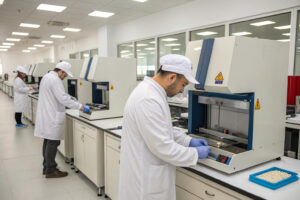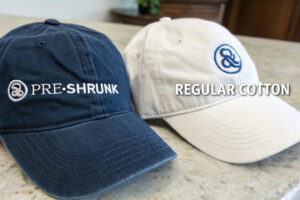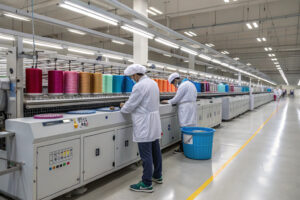Many buyers ask us: how do you keep your defect rates so low across thousands of hat shipments? The answer is simple but not easy—we treat every stage of hat making as a QC checkpoint. From pattern cutting to final packing, our process is designed to detect and correct errors before they reach the customer.
Our 98% QC pass rate comes from CNAS-certified labs, multi-step in-line checks, barcode-tracked components, and dedicated QC teams embedded in every production line.
If you're a hat brand, wholesaler, or importer who’s been burned by quality issues before, let me show you how we do things differently—and how you can demand the same from your supplier.
What QC Tests Are Applied to Every Hat Style?
Different hats require different inspections, but our baseline standard covers fit, function, fabric behavior, and branding accuracy. Whether it’s a sporty trucker cap or a stitched wool beret, nothing leaves our line unchecked.
We apply structural, aesthetic, and safety QC tests including shrinkage, tension, and metal part inspection across all hat styles.

What Are the Most Common QC Checks We Run?
| Test Type | Focus Areas |
|---|---|
| Visual Inspection | Stitching, panel symmetry, stains |
| Dimensional Check | Crown depth, brim curve, head size |
| Functional Test | Snap/Velcro closure, logo peeling |
| Textile Performance | Colorfastness, shrinkage, pilling |
| Hardware Check | Buckle rust test, needle holes |
For export hats, we reference AQL standards, often using 2.5 for major and 4.0 for minor defects.
What Lab Tools Do We Use?
We utilize CNAS-certified equipment like:
- Lightfastness testers (UV fade check)
- Tensile machines for stitching strength
- Wash simulators to ensure logos survive gentle cycles
Similar to tools described by Intertek, our lab ensures hats look and perform as expected—even after shipping, retail display, and wear.
How Is QC Integrated into the Production Process?
In most factories, QC is an end-of-line activity. But that’s too late. We’ve learned that quality assurance starts at pattern cutting—and never stops until the carton is sealed.
Our inline QC model embeds inspectors across each sewing line and fabric station, ensuring early error detection and batch tracking.

What Are the Key Inline QC Stages?
- Fabric Incoming QC: Roll-by-roll visual and shrinkage inspection
- Cutting Table Check: Pattern alignment, warp/weft distortion
- Mid-Line Inspection: After panels are joined, we check symmetry
- Logo Accuracy Test: Color, size, thread tension
- Final Packing QC: Logo placement, stitch count, metal smoothness
Factories that only check at the end suffer from waste and returns. Our internal system reflects what QIMA calls the “Prevention over Detection” model.
How Do We Use Digital QC Tools?
- Barcode tracking for fabric lot + batch
- 98-point QC checklist in English + Chinese
- QC scorecard dashboards for every order
Clients can even access a shared report folder before shipment. Transparency builds trust.
Why Is Lab Testing Critical for Export Success?
Fashion brands shipping globally need more than just nice-looking hats—they need proof that their product meets chemical, durability, and wash standards. That’s where lab testing makes or breaks your QC process.
We test every hat material for colorfastness, fiber composition, shrinkage, and pH balance using ISO-compliant methods and CNAS-certified labs.

What Are the Most Common Tests for Export Markets?
- ISO 105-C06: Colorfastness to washing
- ASTM D1776: Dimensional change in fabrics
- GB 18401-2010: China’s textile safety law for pH and AZO dyes
- EN 71 (Europe): For kid’s wear and trims on baby hats
We work closely with SGS and CTI labs for verified reports. Every batch over 1000 units has at least 1 material test per export.
How Do We Support Clients With Certificates?
- Supply ready-to-print lab sheets
- Apply OEKO-TEX® or GRS hangtags when applicable
- Provide bilingual material composition breakdowns
When we shipped an order of UV bucket hats to Scandinavia last quarter, our QC report was approved in 6 hours because the pH + azo data was already provided proactively.
How Do We Handle Defects When They Happen?
No one can promise 100% perfection—but what matters is how quickly we fix it. While 98% of shipments pass without any issues, we have a system in place for the 2% that need adjustment.
We isolate defects immediately, rework or replace them within 24 hours, and keep defect reports for every job to prevent repeats.

What Is Our Defect Response Process?
- Red Tagging: Every flagged unit gets isolated and tracked
- Repair Crew: Rework team handles fixes within 1–2 shifts
- Full Re-inspection: All repaired units go through fresh QC
- Final Sign-Off: Supervisor certifies before re-packing
We keep samples of all major defect types as part of our training archive—just like what AsiaInspection recommends.
How Do Clients Stay Informed?
- Daily photo updates for major QC rounds
- Summary report with defect breakdown
- Recommendations for future prevention (e.g., reinforced stitching or seam tape)
Our goal is never just to fix—but to learn and reduce the root cause.
Conclusion
Quality doesn’t happen by accident—it’s built into the culture. At Global-Caps, our 98% QC pass rate isn’t just a statistic—it’s a reflection of our process, our team, and our accountability. From inline inspections to lab certifications, from barcode tracking to rework response, we make sure every hat we ship meets international buyer standards.
And that’s why brands, importers, and fashion startups trust us with their next launch.







